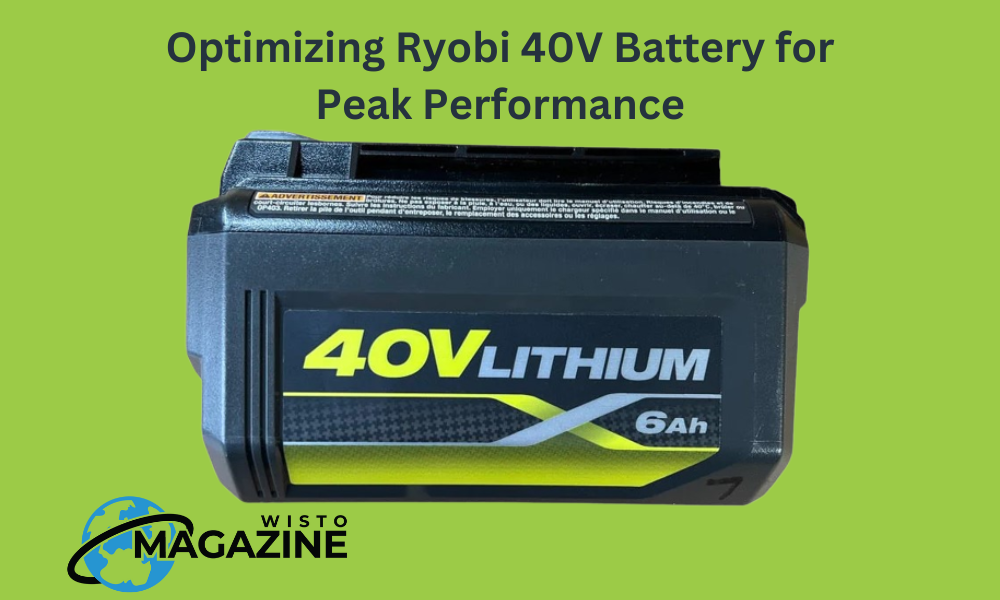Power tools have become indispensable for both professionals and DIY enthusiasts and among the array of choices available, Ryobi stands out with its innovative 40V battery technology. These lithium-ion batteries are renowned for their durability, power, and versatility. Several factors come into play to optimize the performance of your Ryobi 40V battery and make the most out of your tools.
Understanding the Ryobi 40V Battery
The Ryobi 40V battery is a lithium-ion powerhouse designed to provide high performance and long-lasting energy for a range of power tools. Before diving into optimization, understanding its characteristics is crucial:
High Capacity
The 40V battery pack boasts a high energy capacity, offering prolonged usage compared to lower-voltage counterparts.
Lithium-ion Technology
Lithium-ion batteries provide consistent power output and are known for their longevity, maintaining a stable charge over numerous charge cycles.
Compatibility
These batteries are designed to be compatible with a wide range of Ryobi 40V tools, enhancing their versatility.
Optimal Charging Practices
Initial Charge
Upon purchasing a new Ryobi 40V battery, it’s advisable to fully charge it before the first use to condition the cells and maximize their lifespan.
Use Ryobi Chargers
Always use Ryobi-approved chargers specifically designed for the 40V batteries to ensure the correct charging voltage and avoid damage.
Avoid Overcharging
Lithium-ion batteries can degrade if overcharged. Remove the battery from the charger promptly after reaching a full charge to prevent unnecessary stress on the cells.
Storage Conditions
Store batteries in a cool, dry place away from extreme temperatures. If storing for an extended period, ensure they have a partial charge, typically around 50%, to maintain cell health.
Usage Tips for Maximizing Battery Life
Proper Tool Selection
Match the tool to the task at hand. Using a tool that is appropriately sized and powered for the job can prevent unnecessary strain on the battery.
Avoid Deep Discharges
Lithium-ion batteries perform better when not fully discharged. Recharge the battery before it drains completely to prolong its lifespan.
Cool-down Periods
Allow the battery to cool down between uses, especially during heavy-duty tasks. This prevents overheating and ensures optimal performance.
Maintaining Battery Health
Regular Inspections
Periodically inspect the battery for any signs of wear, damage, or corrosion. Clean the contacts if necessary and replace damaged batteries promptly.
Firmware Updates
Stay updated with any firmware or software upgrades provided by Ryobi for the battery or tools. These updates often enhance performance and safety features.
Recycle Properly
When the battery reaches the end of its life cycle, ensure proper recycling or disposal, as lithium-ion batteries require special handling.
Frequently Asked Questions (FAQs)
Q1: How long does it take to charge a Ryobi 40V battery fully?
The charging time for a Ryobi 40V battery can vary based on its capacity and the charger used. Typically, it takes around 90 minutes to 2 hours for a full charge with Ryobi’s recommended chargers.
Q2: Can I use a different charger for my Ryobi 40V battery?
It’s highly recommended to use Ryobi-approved chargers specifically designed for the 40V batteries. Using unauthorized chargers might affect the battery’s performance and lifespan.
Q3: Is it better to store the battery fully charged or partially charged?
For long-term storage, it’s recommended to store lithium-ion batteries at around a 50% charge in a cool, dry place. Storing them fully charged or completely drained for extended periods can impact their overall health.
Q4: How can I maximize the lifespan of my Ryobi 40V battery?
To extend the lifespan of your battery, avoid deep discharges, use the appropriate tool for the task, and follow proper charging practices. Regular inspections, firmware updates, and proper recycling at the end of the battery’s life cycle are also crucial.
Q5: Can I leave my Ryobi 40V battery on the charger after it’s fully charged?
It’s advisable to remove the battery from the charger once it reaches a full charge. Leaving it connected to the charger unnecessarily can lead to overcharging, potentially impacting the battery’s longevity.

